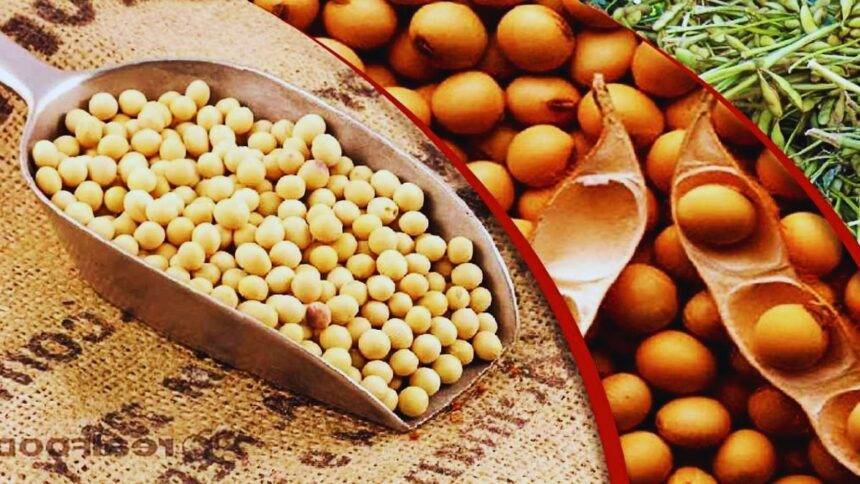Main Points In Hindi (मुख्य बातें – हिंदी में)
यहां पर दिए गए अंश के मुख्य बिंदु निम्नलिखित हैं:
-
सोयाबीन की मूल्य में बड़ा अंतर: खुदरा और बाजार मूल्य के बीच सोयाबीन के लिए एक बड़ा अंतर देखा जा रहा है। सरकार ने मूल्य को नियंत्रित करने के लिए कुछ कदम उठाए हैं, लेकिन वे सफल नहीं हो रहे हैं। वर्तमान में, सोयाबीन का बाजार मूल्य एमएसपी (न्यूनतम समर्थन मूल्य) से नीचे है।
-
खाद्य तेलों के खुदरा मूल्य में वृद्धि: पिछले दो महीनों में विभिन्न प्रकार के खाद्य तेलों, जिसमें सोयाबीन तेल भी शामिल है, की खुदरा कीमतें 18-44 प्रतिशत तक बढ़ गई हैं। यह स्थिति महाराष्ट्र में विधानसभा चुनावों में एक प्रमुख मुद्दा बन गई है।
-
कृषि मंत्रालय के उपाय: सरकार ने रबी सत्र में सोयाबीन खरीद का समर्थन बढ़ाने के लिए नाफेड और एनसीसीएफ जैसी एजेंसियों को 15% नमी पर सोयाबीन खरीदने की अनुमति दी है। इसके अलावा, आयात ड्यूटी में बढ़ोतरी का उद्देश्य घरेलू तेलबीज की कीमतों को बढ़ाना है, क्योंकि देश अपनी आवश्यकताओं का 58% आयात करता है।
-
निम्नतम समर्थन मूल्य (MSP) एवं mandi मूल्य: वर्तमान में मंडियों में सोयाबीन का औसत मूल्य 4500 से 4700 रुपये प्रति क्विंटल है, जबकि 2024-25 सत्र के लिए घोषित एमएसपी 4892 रुपये प्रति क्विंटल है।
- सरकारी खरीद और योजनाएँ: सरकार ने वर्तमान खरीफ सत्र में किसानों से 76,000 टन सोयाबीन की खरीद की है, और विभिन्न राज्यों में उत्पादन बढ़ाने के लिए कदम उठाए हैं।
ये बिंदु सोयाबीन की मूल्य स्थिति और सरकारी प्रयासों का सारांश प्रस्तुत करते हैं।


Main Points In English(मुख्य बातें – अंग्रेज़ी में)
Here are the main points from the provided text about the soybean market situation:
-
Price Discrepancy: There is a significant gap between the retail prices of soybean and the market prices, with retail prices rising sharply (up to 44%) over the last two months, while actual market prices remain below the Minimum Support Price (MSP) of Rs 4,892 per quintal.
-
Government Interventions: Despite the government’s measures such as increasing import duties on edible oils and allowing procurement of soybean at a higher moisture content, these actions have not succeeded in elevating soybean prices to the MSP level.
-
Market Conditions: Current average mandi prices for soybean are between Rs 4,500 to Rs 4,700 per quintal, influenced by factors including high moisture levels in the crop, which have contributed to lower market pricing.
-
Recent Purchases: In the past two months, government agencies like NAFED and NCCF have procured 76,000 tonnes of soybean at MSP across several states, an increase from 70,000 tonnes purchased during the previous season.
- Import Dependence: The country relies heavily on imported edible oils, accounting for about 58% of its consumption, which has prompted the government to implement measures to boost domestic production to mitigate these import levels.
Complete News In Hindi(पूरी खबर – हिंदी में)
सोयाबीन के खुदरा और बाजार मूल्य में बड़ा अंतर देखा जा रहा है। सरकार ने इस मूल्य को नियंत्रित करने के लिए कुछ कदम उठाए, लेकिन वे सफल नहीं हो रहे हैं। दो महीने पहले, केंद्रीय सरकार ने विभिन्न प्रकार के खाद्य तेलों पर आयात शुल्क बढ़ा दिया और ऐलान किया कि तिलहनों को न्यूनतम समर्थन मूल्य (MSP) पर खरीदा जाएगा। इन कदमों के बावजूद, मुख्य खैरिफ फसल सोयाबीन का मूल्य अभी भी MSP से नीचे है।
इस बीच, सोयाबीन सहित सभी प्रकार के खाद्य तेलों की खुदरा कीमतों में पिछले दो महीनों में 18-44 प्रतिशत की तेज वृद्धि हुई है। महाराष्ट्र में, जहाँ आज विधानसभा चुनाव हो रहे हैं, सोयाबीन की कम कीमतें एक बड़ा मुद्दा बन गई हैं।
सोयाबीन का बाजार मूल्य क्या है?
सूत्रों के अनुसार, वर्तमान में सोयाबीन के औसत मंडी मूल्य 4500 से 4700 रुपये प्रति क्विंटल के बीच चल रहे हैं, जबकि 2024-25 सीजन के लिए MSP 4892 रुपये प्रति क्विंटल घोषित किया गया है। कीमतों में गिरावट का मुख्य कारण फसल में उच्च मात्रा में नमी है।
अधिकारीयों ने बताया कि खाद्य तेलों पर आयात शुल्क बढ़ाने का मुख्य कारण घरेलू तिलहनों के मूल्य को बढ़ावा देना है, क्योंकि देश अपनी वार्षिक जरूरतों का लगभग 58 प्रतिशत आयात करता है। हाल ही में राज्यों को भेजे गए एक पत्र में, कृषि मंत्रालय ने नाफेड और राष्ट्रीय सहकारी उपभोक्ता महासंघ (NCCF) जैसी एजेंसियों को सोयाबीन को 15% नमी पर खरीदने की अनुमति दी है, बशर्ते कि राज्य इसका खर्च उठाए। इससे किसानों से खरीद बढ़ने की उम्मीद है।
उपभोक्ता मामले विभाग के डेटा के अनुसार, पिछले दो महीनों में सरसों के तेल, सोयाबीन तेल, सूरजमुखी और पाम तेल की खुदरा कीमतें क्रमशः 165 रुपये प्रति लीटर, 154 रुपये प्रति लीटर, 159 रुपये प्रति लीटर और 144 रुपये प्रति लीटर हो गई हैं। यह पिछले कीमतों की तुलना में क्रमशः 18 प्रतिशत, 28 प्रतिशत, 32 प्रतिशत और 44 प्रतिशत की वृद्धि है।
कितना सोयाबीन खरीदा गया?
पिछले दो महीनों में, नाफेड और NCCF ने कृषि मंत्रालय की मूल्य समर्थन योजना (PSS) के तहत मध्य प्रदेश, महाराष्ट्र, राजस्थान, कर्नाटक, गुजरात और तेलंगाना से किसानों से 76,000 टन सोयाबीन MSP पर खरीदी है।
सितंबर में, जब मंडी की कीमतें MSP से नीचे थीं, तब कृषि मंत्रालय ने मध्य प्रदेश (1.36 लाख टन), महाराष्ट्र (1.3 लाख टन), राजस्थान (0.29 लाख टन), कर्नाटक (0.1 लाख टन) और गुजरात (0.09 लाख टन) व तेलंगाना (0.05 लाख टन) से किसानों से 3.22 लाख टन सोयाबीन खरीदने की अनुमति दी।
2023 के खैरिफ सीजन में, एजेंसियों ने किसानों से 70,000 टन सोयाबीन MSP पर खरीदी। 14 सितंबर से, सरकार ने कच्चे पाम, सोयाबीन और सूरजमुखी तेलों पर आयात शुल्क 5.5 प्रतिशत से बढ़ाकर 27.5 प्रतिशत और रिफाइंड खाद्य तेलों पर 13.75 प्रतिशत से बढ़ाकर 35.75 प्रतिशत कर दिया। इसका उद्देश्य घरेलू उत्पादन को बढ़ावा देना था, क्योंकि देश 24-25 लाख टन खाद्य तेल का 58 प्रतिशत आयात करता है।
इसके अलावा पढ़ें: मध्य प्रदेश ने महाराष्ट्र को पीछे छोड़कर सोयाबीन की खरीद में बढ़त बनाई, जानें अन्य राज्यों की स्थिति।
पिछले रबी सीजन में, 2023-24 फसल वर्ष में (जुलाई- जुन) रिकॉर्ड सरसों उत्पादन 13.16 लाख टन के बावजूद, मंडी की कीमतें MSP से नीचे चल रही थीं और सरकारी एजेंसियों ने हरियाणा, मध्य प्रदेश, राजस्थान और उत्तर प्रदेश जैसे राज्यों में 1.2 लाख टन सरसों खेतों से खरीदी थी।
Complete News In English(पूरी खबर – अंग्रेज़ी में)


A huge difference is being seen between the retail and market prices of soybean. The government had also taken some measures to keep this price down, but they are proving unsuccessful. Two months ago, the central government had increased the import duty on different variants of edible oils and announced that oilseeds would be purchased at MSP. Despite these steps, the price of soybean, the main Kharif crop, is still below the MSP.
This is when retail prices of all types of edible oils including soybean have increased sharply in the range of 18-44 percent in the last two months. In Maharashtra, where assembly elections are being held today, low soybean prices have been a major issue.
What is the market price of soybean?
Sources told ‘Financial Express’ that the average mandi prices of soybean are currently running between Rs 4500 to Rs 4700 per quintal, while the MSP of Rs 4,892 per quintal was declared for the 2024-25 season (July-June). Is. The main reason for falling prices is the high amount of moisture in the crop.
Also read: These 5 easy methods can reduce the moisture of soybean, you can try it in your barn itself.
Officials said that the main reason behind increasing the import duty on edible oils was to boost the prices of domestic oilseeds, because the country imports about 58 percent of its annual requirements. In a recent letter sent to the states, the Agriculture Ministry has allowed agencies like NAFED and the National Cooperative Consumers Federation of India (NCCF) to procure soybean at 15% moisture instead of the prescribed 12%, provided the states bear the cost, Due to which purchases from farmers are expected to increase.
According to consumer affairs department data, retail prices of mustard oil, soybean oil, sunflower and palm oils have risen to Rs 165 per litre, Rs 154 per litre, Rs 159 per liter and Rs 144 per litre, respectively, from two months ago. There is an increase of 18 percent, 28, 32 and 44 percent compared to the prices of Rs.
How much soybean was purchased?
In the last two months, NAFED and NCCF have purchased 76,000 tonnes of soybean at MSP from farmers in Madhya Pradesh, Maharashtra, Rajasthan, Karnataka, Gujarat and Telangana under the Price Support Scheme (PSS) of the Agriculture Ministry in the current Kharif season.
In September, when mandi prices were below the MSP due to low import duty on edible oil, the Agriculture Ministry had increased production under PSS to Madhya Pradesh (1.36 MT), Maharashtra (1.3 MT), Rajasthan (0.29 MT), Karnataka (0.1 MT), procurement of 3.22 million tonnes (MT) of soybean from farmers of Gujarat (0.09 MT) and Telangana (0.05 MT) was approved.
In the 2023 Kharif season, the agencies had purchased 70,000 tonnes of soybean from farmers at MSP. From September 14, the government had increased the import duty on crude palm, soybean and sunflower oils from 5.5 percent to 27.5 percent, while the duty on refined edible oil increased from 13.75 percent to 35.75 percent. Its objective was to boost domestic production as the country imports about 58 percent of its edible oil consumption of 24-25 metric tons.
Also read: Madhya Pradesh overtakes Maharashtra in soybean purchase, know the situation of other states
In the last Rabi season, despite a record mustard production of 13.16 MT in the 2023-24 crop year (July-June), mandi prices were trending below the MSP and government agencies had issued orders in states like Haryana, Madhya Pradesh, Rajasthan and Uttar Pradesh. 1.2 metric tons of mustard was purchased from farmers of major producing states.




